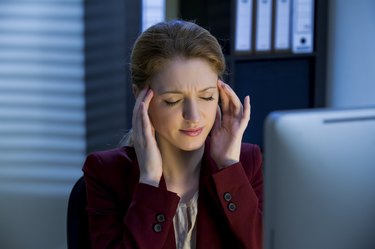
According to the National Headache Foundation, about 29.5 million people in American suffer from migraine symptoms, including soreness in the temples. Temple soreness can be painful and debilitating, interfering with daily activities and relationships. This makes it extremely important to understand what causes it to occur and how it can be treated.
Symptoms
Video of the Day
Migraine headaches can cause mild to severe pain and soreness in the temples and sides of the head. This pain can throb or pulse in the temples and worsen with physical activity such as exercise. In addition, symptoms can include light sensitivity, nausea, vomiting and sensitivity to sound. You can also notice changes in vision such as flashes of light or zigzag shaped lines and temporary vision loss. Migraine symptoms, including temple soreness, typically last anywhere from four to 72 hours.
Video of the Day
Causes
Sore temples caused by migraine headaches develop when alterations occur in the serotonin levels of the brain. As a result, the blood vessels swell or constrict, causing temple soreness and other migraine symptoms. Many conditions and circumstances can cause the serotonin levels in the brain to fluctuate, including hormonal changes, certain foods such chocolate, blood sugar level alterations, stress, lack of sleep, bright light, physical exertion and strong scents.
Treatments
To treat soreness in the temples caused by migraines, take an over-the-counter medication such as acetaminophen, ibuprofen or aspirin as soon as symptoms develop. Lie down in a quiet, dark room and wrap an ice pack around the back of your head and gently massage the temples. Try a relaxation technique such as mediation or progressive muscle relaxation. For chronic or severe migraine temple soreness, a doctor can prescribe a medication such as sumatriptan, naratriptan, ergotamine or dihydroergotamine.
Prevention
To prevent migraine-caused temple soreness, keep a headache diary. In it, note what your sleep habits were that day, what foods or scents you were exposed to and your stress levels. This can help you pinpoint specific triggers to avoid in the future. Consistent exercise can also help reduce tension and obesity, both migraine factors. Just be sure to warm up — sudden physical exercise can trigger a migraine.
Is this an emergency? If you are experiencing serious medical symptoms, please see the National Library of Medicine’s list of signs you need emergency medical attention or call 911.